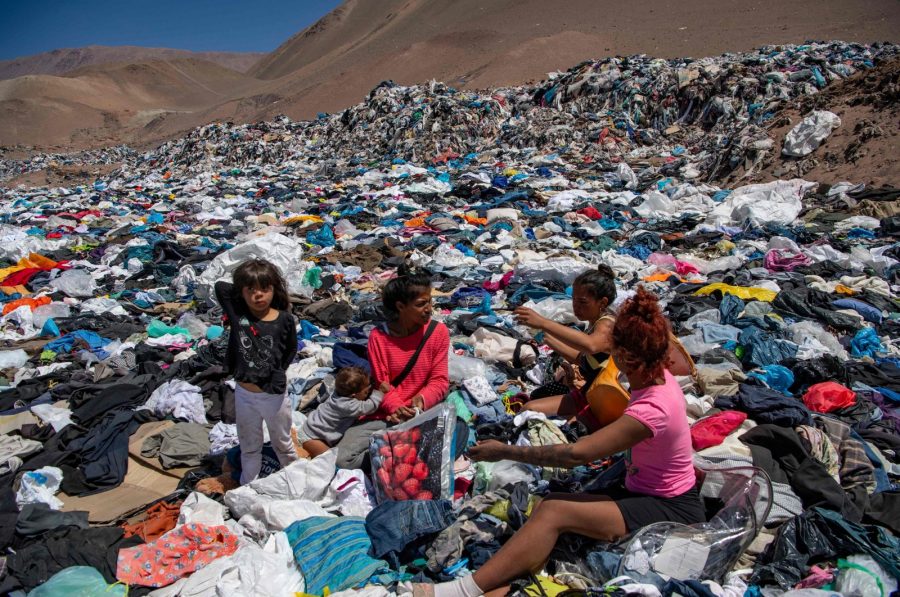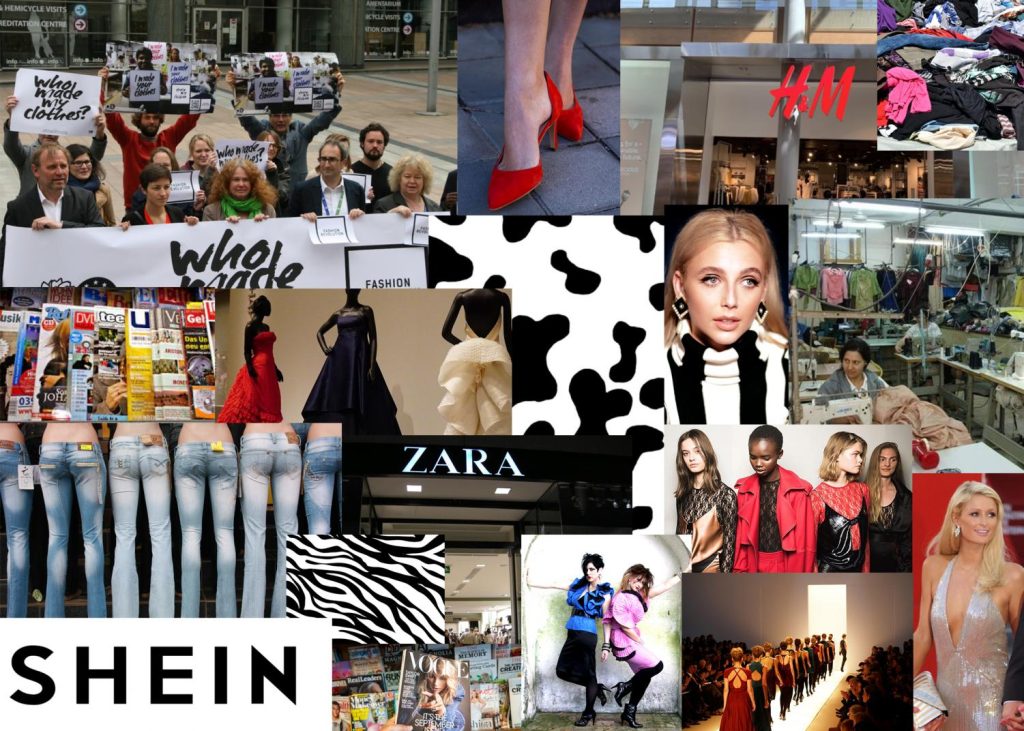
Photo courtesy: University of Washington
Catherine Stuart-Chaffoo
As the fashion industry quickly cycles through trends in an attempt to keep up with ever-changing consumer demands, style has seemingly become a disposable commodity, and this practice, in recent years, has created significant environmental impacts and labor exploitations that can no longer be ignored.
Amid growing awareness of these issues, coupled with rising economic inflation making sustainable clothing increasingly unaffordable for many consumers, the industry finds itself in a current state of limbo, caught between conflicting demands: balancing affordability and accessibility.
This pressure to produce products at a high speed and large volume is, in a sense, an oxymoron, but yet it is a challenge that the fashion industry must address to prevent further negative impacts that will soon pose irreversible damage.
WHAT IS FAST FASHION?

Fast fashion doesn’t just mean that clothing is produced quickly, it’s what goes on behind the scenes to meet the consumer demands that makes it so problematic in practice.
Fast fashion, according to Vogue Magazine, in simple terms can be defined as “quickly produced trends sold at low price points.” Selling garments at such a low price cannot result in companies earning a profit unless the way the clothes are produced is also very cheap.
Manufacturing clothes in the United States can be very expensive, so many fast fashion companies will outsource to foreign countries that do not have the same labor laws in place as the United States, such as China or Taiwan to manufacture their product, so that they can pay the workers less money.
Additionally, the materials fast fashion companies manufacturers use to produce their products are very low in quality and generated in mass amounts, making the product only able to withstand a handful of wears.
(Photo courtesy: The Tower)
WHY IS FAST FASHION A PROBLEM?
Outsourcing manufacturers from other countries with less strict or little to no labor laws is problematic in itself as it supports unethical labor practices. Workers for fast fashion companies work countless hours, are paid very little, and the workers are sometimes children.
Beyond worker conditions, fast fashion poses significant environmental threats. The material fast fashion manufacturers use is not only lacking in quality, but their garments are not biodegradable and are typically made out of materials like polyester.
Because of the poor quality and non-environmental friendly materials, garments are often discarded after a handful of wears and end up piled up in a landfill along with the leftover mass-produced product from the manufacturer that was never sold to begin with.
(Photo courtesy: FracTracker Alliance)

SHORT TERM PROBLEMS
- Poor quality garments
- Wardrobe based on micro-trends rather than timeless pieces
- Discarding clothes fairly often/ not even wearing them at all
LONG TERM PROBLEMS
- Supporting/ worsening working conditions in foreign countries
- Filling landfills with either untouched or lightly used clothing that will take millions of years to decompose, if at all.
- Poor-quality garments will begin tainting brands that used to be known for their high quality in an attempt to keep up with consumer demands that can only be met by unethical practices
INSIDER LOOK INTO THE WORLD OF FAST FASHION

Darcea Scott-West, director of quality assurance for Calvin Klein, believes that fast fashion is a complex and multi-faceted issue.
(Photo courtesy: LinkedIn.com)
“It’s not just the companies we know as fast fashion that are engaging in these unethical practices, there are just some companies who are more open about it than others. It’s a problem that has plagued the industry, and needs to be addressed.”
Fast fashion companies are mass producing their products, and often excessively according to West, causing not only the clothes they do sell to end up in landfills because they don’t hold up well after a few wears, but the clothes they never sell go there as well.
Working in the fashion industry herself, West urges that it is difficult to keep up with the demand of consumers, and that balancing meeting those demands, and doing so in an ethical way is a constant battle for many fashion brands.
Addressing such a complex issue is not going to be resolved by telling people to stop shopping from fast fashion, especially because for many people, the real motivator to keep shopping from these brands is the fact that they are more affordable.
Smith does think straying away from the overconsumption habits is a step in the right direction. Beyond the consumer, she does also suggest that more ethical brands having more reasonable prices and the fast fashion brands not being able to sell their garments for a couple of dollars may force consumers to look at clothing for quality instead of just price point.
Larger steps can be implemented, such as governmental regulations about producing things overseas, and companies themselves being held accountable for unethical production practices, but Scott admits she does not know what it will take for those kinds of measures to become the standard.

Liv Yankovich, an LMU alum who currently works in entertainment relations at Jimmy Choo, thinks fast fashion is extremely unethical, and a very difficult problem to solve.
(Photo courtesy: LinkedIn.com)
“I think people know that fast fashion is bad. Educating people isn’t enough because many people don’t care about the problems it is causing. We need to make real changes on the manufacturing end.”
Beyond the impacts, Yankovich thinks fast fashion is a reflection of how we are a consumer society, and how we have a concerning over-consumption problem. She says this problem may be rooted in the constantly changing micro-trends that people who purchase from fast fashion brands are trying to keep up with.
Yankovich, echoes Scott’s thoughts on possible solutions to mitigate the impacts that fast fashion pose, emphasizing that consumers need to slow down their buying, but at the same time, these brands should not be going to these drastic of measures to meet consumer demands when the repercussions are so vast.
She thinks policy changes or a governmental ban on importing goods from foreign manufactures that do not abide by United States labor laws would force consumers to really think about what it is that they are buying.
At the very least, Yankovich thinks consumers should most definitely be avoiding the extreme fast fashion brands such as SHEIN or TEMU, as those pose the most serious threats to our environment and the people that are producing those textiles.

Madeleine MacGilivray, a climate scientist and a Climate Communications and Policy Coordinator at Seeding Sovereignty, where she educates and organizes at the intersection of plastics and climate, is currently working on tangible solutions to minimize the impacts of fast fashion.
(Photo courtesy: madeleinemacgillivray.com)
“When we are talking about fast fashion, we are not just talking about polluting the environment, we are also talking about the fact that the majority of workers are women in the global South that don’t get paid a living wage. It’s a human rights issue as well as a environmental one.”
MacGilivray’s career has primarily been focused on addressing major contributors to climate change and pollution in our environment, and she says because of this, fast fashion has always been on her radar, and “desperately needs to be addressed.”
Although she also agrees that educating people is not necessarily enough, she does think that if the conversation is held through a more “humanistic lens,” people may be more receptive to it. The workers who are assembling these garments are exposed to dangerous chemicals and toxic dyes that pose threats to their health.
MacGilivray thinks that these issues that are directly impacting the health of others is just as, if not more important than the pollution aspect of fast fashion.
If those kinds of conversations aren’t enough to make a difference, MacGilivray is optimistic that projects like the one she is currently working on with CICLO, a “nature based solution to reducing plastic microfiber pollution.”
CICLO has already partnered with major companies like Target and Walmart, according to MacGilivray, and if larger compabies continue to use their material in their garnments, fast fashion materials have the potential to biodegrade at the rate similar to wool.
Learn more about how CICLO works here: https://www.facebook.com/reel/457325013829006
Magilivray acknowledges that this solution, although revolutionary, is still not as cost-efficient for companies, but hopes that their partnerships with big-named brands will get the ball rolling, and hopefully inspire other companies to prioritize ethics.

Lorynn Divita, Associate Professor of Apparel Design and Merchandising at Baylor University, and author of Fashion Forecasting, says that over the course of her career, she has watch the fashion industry dramatically change – as the prices for consumers has gone down, so has the quality of merchandise and ethics of how these goods are manufactured.
“Just because it’s [fast fashion] not affecting us, in terms of not being able to see it, it is affecting people, and we need to understand the full impact and try to make all of our consumption as ethical as possible.”
Beginning her career in the 90s, Divita says the fashion industry has shifted from producing goods here in the United States, to manufacturing in other countries to keep up with consumer demands.
Outsourcing manufacturing of textiles poses massive environmental and economic problems that are impacting third world countries, which is why Divita thinks many consumers in the United States don’t see their consumption habits as problematic – because it doesn’t directly impact them.
Divita is aware that many consumers frankly don’t care about the problems fast fashion poses, but she is hopeful that looking at its impacts through a humanistic lens will at least divert some people from consuming fast fashion.
Beyond supporting these unethical brands, the other part of the problem lies in the fact that our society over buys and over discards.
Educating consumers about being more mindful about what they need versus what they want, and thinking about the quality of clothing and how many wears you will get out of it will allow for less mindless shopping.
Divita believes it’s truly in the hands of the consumers to boycott these unethical brands, because brands have to be receptive to their consumers. She says that if consumers demand a change, the fashion industry will have to make one, she’s just not sure what it will take to get to that place.
CONSUMER OPINIONS ON FAST FASHION
I sent out a survey to USC students regarding their fast fashion consumption rates, their opinions on fast fashion as a whole, and what kinds of strategies they think would help mitigate the problems fast fashion poses.
Here’s how they responded:
How often do you consume fast fashion?
Why do you or why do you think others purchase from fast fashion brands? (select all that apply)
What problems do you or others you know find when purchasing from fast fashion brands? (written responses)
- Poor quality
- It takes a while to get
- Bad quality, doesn’t last
- Child labor
- Bad quality materials, a lot of polyester/ do not last
- It’s lower quality and I face issues with shipping
- Quality of items
- Don’t last long as pieces, feel cheap
- Clothing is not made to last and is often of cheap quality
- Cheap quality
- They don’t last long and are not durable. Fall apart in the washing machine after I wear them a few times. But they are often trending pieces that only stay in style for a month or two.
- Not the best quality, labor exploitation
- Cheap quality and questionable ethics
- Quality varies between items sometimes, but the issue with fast fashion is the price is so good for the product that people have no other option than to buy it if they want to get something affordable
- Inconsistency in product, sizing, material, what is shown online, etc. There is also the moral issue of purchasing something made by overworked and underpaid adults or children. Fast fashion also contributes to the climate crisis and waste.
- It’s bad quality and normally meant for one or two uses. Leaking colors, cheap material
- Trends die, but quality doesn’t, it’s so much more affordable in the long run to buy sustainably
- Cheaper products
- Not environmentally conscious, unethical worker treatment, low-quality materials
- Quality is poor
- Horrible quality and doesn’t last or fit well
- Poor Quality. Labor violations. Very poor environmentally
- Quality!!!
- Poor quality
- Quality is not great & environmental sustainability issues
- Poor quality/clothing doesn’t last more than a few wears
- Lower quality that doesn’t last as long, shipping can take a while because of how far it has to travel
Do you think educating the public on the negative impacts of fast fashion will cause people to stop shopping from fast fashion brands?
If you answered no to the previous question, what kinds of approaches would you recommend to lessen the negative impacts of fast fashion? (written responses)
- Making other alternatives more affordable
- One that entices emotion out of them most of the time we just hear about it, but it doesn’t really urge people to stop.
- Decrease the price of other fashion
- Lessen the cost of clothes overall, so that they can afford slow fashion brands as well
- To make sustainable and ethical fashion more accessible, relevant, and affordable.
- Pushing for more government regulation on fast fashion.
- Shut down Shein (maybe a documentary of the inside of their facilities) …a REAL one
- Not only educating the public but creating a boycott movement will get people to stop buying and put pressure on fast fashion companies to change their way
- Enforcing taxes or fees that make fast fashion more expensive. Generally speaking, people will only respond to what affects them directly.
- I think educating people on mediums like TikTok where fast fashion brands are promoted is good because people will be less likely to buy fast fashion as often, but I don’t think it will be able to stop entirely because it’s more affordable than high-end clothes.
- Increasing the prices with taxes or tariffs
- Laws that make it illegal to sell products in the US to sell products of slavery or bad environmental conditions.
- (I answered yes but to be honest, I feel like it’s maybe because some people really can’t afford to buy nicer items, and sometimes the reality of how awful fast fashion won’t change someone’s outlook bc of the desire to fit in or have clothes that they like and also be able to afford food, housing and other more necessary expenses) but I think people who actually can afford normal clothes and not fast fashion should be educated and aware and make conscious decisions to not participate in fast fashion as it’s not their only option to be able to get clothes
- Government regulation, boycotts
- I don’t know for sure but I think that people are more stressed about economics right now as people can’t afford to live so I think we need to encourage investment pieces
- Clothing reclamation programs. Prioritization of quality and less trend-focused fashion.
- Simultaneously pushing for better pay and rights for the sweatshop workers as well as educating more people on affordable small brands!!
- This is a hard question! I think some people just don’t care about fast fashion b/c they want trendy stuff for cheap. I would want people who learn about the environmental impacts to stop buying fast fashion, but it may be a larger fashion industry pricing issue that needs to be fixed first. maybe if influencers started talking about the impacts of fast fashion more instead of just doing hauls on fast fashion it could help spread the word.
- Educating people on alternate companies or how to easily tell fast fashion apart from other brands
SO… WHAT NOW?
If we shift our focus from price alone and start valuing the quality and longevity of the clothes we buy, we can collectively reduce the demand for fast fashion.
By choosing items that will last longer and serve us for more wears, we send a powerful message to the industry that durability and sustainability matter.
Ultimately, the future of fashion is in our hands, and with more conscious choices, we can help drive a shift toward a more sustainable and ethical fashion industry.
Leave a Reply